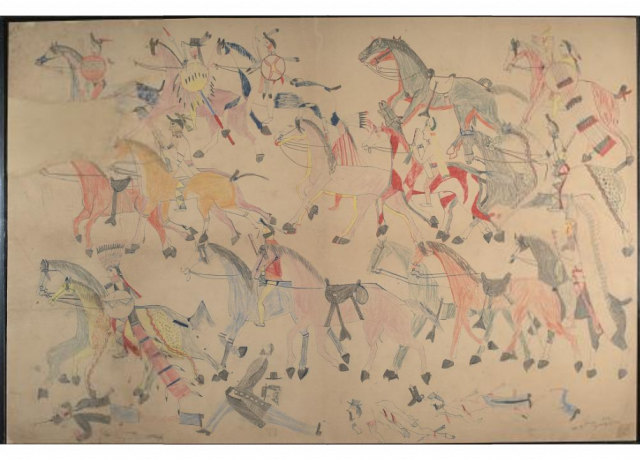 Red Horse pictographic account of the Battle of the Little Bighorn, 1881
Red Horse pictographic account of the Battle of the Little Bighorn, 1881Posted on 01/21/2019 12:17:14 AM PST by vannrox
In most cases, movies based on real incidents tend to make those events more exciting. Not so in the case of Custer’s Last Stand. Of course, moviegoers wouldn’t likely want to see all of the scalping, animal killing, decapitation and other grim horrors of this battle.
There would not be enough time in these movies to allow for the minor but still intriguing facts surrounding Little Big Horn.
These facts and/or believed stories are well worth to read!
The Cavalry, armed with single shot carbines was no match against Native Americans with far more firepower. They were up against 100 repeating Winchesters and more Indian firearms numbering as many as 350 total. It was an onslaught they were unprepared for.
These Cavalry soldiers were possibly not all well trained. There were several minors that were not yet of military age among them, and several of the men found in archeological excavations were not in military uniform. Indian accounts of the battle describe the men as scared and in a panic.
By most accounts, many of the men ran away from the carnage to make defense farther up, and it was on Custer Hill that Lt. Edward Godfrey and General Edward McClerand (and later confirmed by archeologists) found the bodies of Cavalry men surrounded by a circle of dead horses.
“On top of Custer Hill was a circle of dead horses with a 30-foot diameter, which was not badly formed. Around Custer some 30 or 40 men had fallen, some of whom had evidently used their horses as breastworks.” – General McClerand
“Numerous dead horses were lying along the southwestern slope of Custer Hill. On the very top were found four or five dead horses that were swollen, putrid, and offensive, their stiffened legs sticking straight out from their bodies. Close under the brow of the hill several horses are lying together, and by the side of one of these Custer was found.” – Colonel John Gibbon
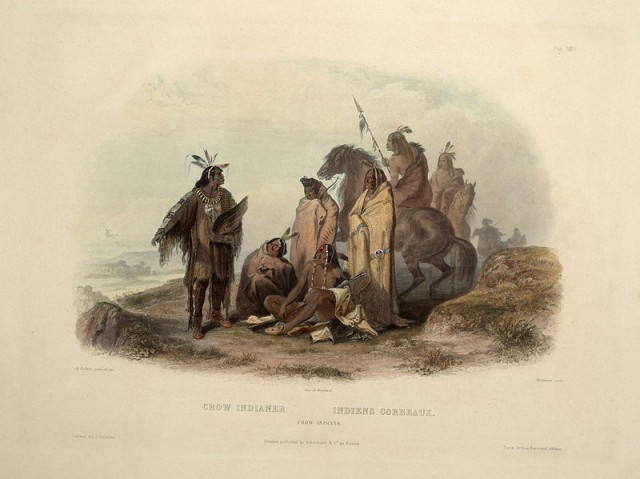 Crow indians
Crow indiansCrow Chief Plenty Coups had a vision as a child that if his nation was to survive, it would need to befriend the coming white man. He stuck to that his entire life, and upon his death in the 1920s; he donated his home to the National Park Service.
The Crow were originally from Lake Erie, but in the 1700s were pushed Westward by other tribes to first Manitoba, and then by the Cheyenne and Sioux into Montana. The Crow territory included Little Big Horn, and in 1851, that land was included in the reservation boundaries set by the U.S. government for the Crow nation.
For decades, nearly a century, before the formation of the Crow reservation and the Crow’s alliance with the U.S., the Cheyenne, and Sioux had been stealing Crow horses and warring with the less armed nation on a regular basis. They were, in a sense, bullies.
In 1868, after battling with the Sioux, the U.S. signed the Treaty of Fort Laramie, which gave the Lakota Sioux territory up to the crest of the Bighorn Mountains. The Sioux treatment of the Crow became worse, and in the two years leading up to the battle with Custer, it escalated and it further involved the U.S. Army.
The Crow did not have enough numbers to defend themselves and neither did the Army, but together they were better off. Sioux made numerous raids on the Crow and Army outposts, and the Crow would often sacrifice their warriors in attempts to recover stolen horses and goods.
Indian Agent Dexter Clapp began to plead with the government for assistance in helping the Crow. He said, “As long as they are being driven from point to point, there is no use asking them to settle down and farm.” Clapp himself, in the meantime, armed the Crow with guns and ammunition. “The Sioux are now occupying the eastern and best portion of their reservation, and by their constant warfare, paralyzing all efforts to induce the Crows to undertake agriculture.”
It wasn’t only the Crow that were being pushed around by the Sioux; other nations included Shoshone, Blackfeet, and Arikaras.
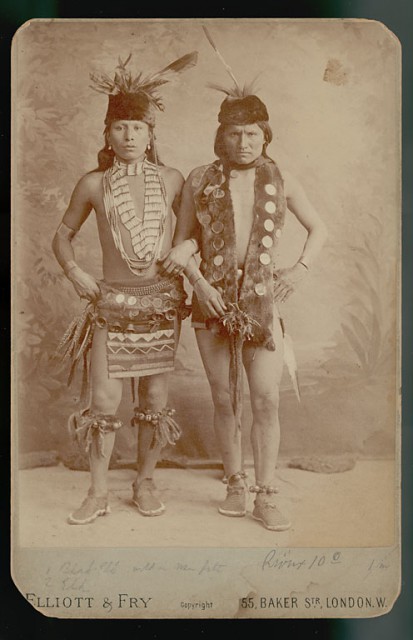 Black Elk and Elk – Oglala Lakota
Black Elk and Elk – Oglala LakotaDuring the battle, in addition to scalps, the Sioux took things from the soldier’s bodies that intrigued them.
Watches were seen only as an object that ticked, and once the ticking stopped, they were mostly discarded. Black Elk says of one that he took from a soldier’s belt “It was round and bright and yellow and very beautiful, and I put it on me for a necklace. At first, it ticked inside and then it did not anymore.”
They also found compasses and saw that the needle floated and moved when the compass case was turned. Because of their position to the bodies of the dead soldiers, the compass happened to point at the bodies. They concluded that the device was attuned to the soldiers, and that’s how the white men found each other.
Paper money was of no use as it was seen as green art and was given to the children or thrown away. The wallets, however, were worth more and were kept – an interesting and opposite perspective than ours, but probably more correct.
The Warriors also found flasks. They assumed the strong, burning liquid inside was “holy water” and that it was this drink that made the soldiers act strangely – shooting at each other and committing suicide in panic.
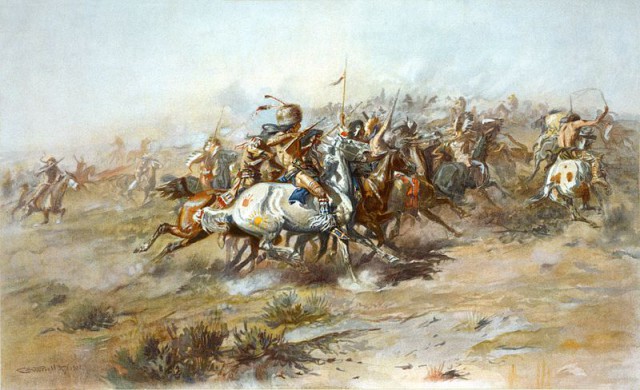 Battle of Little Bighorn
Battle of Little BighornAfter Custer himself fell, the remaining soldiers fled in a disorganized panic toward a stand of cottonwood. The stampede was such that an Indian warrior compared it with a “hunting buffalo”.
“The white men went crazy. Instead of shooting us, they turned their guns upon themselves. Almost before we could get to them, every one of them was dead. They killed themselves.” – Wooden Leg
“More and more soldiers were getting off their horses, preferring to hide or crawl along the ground . . . As hundreds of Indians surrounded this ridge, I saw one of the soldiers point his pistol at his head and pull the trigger. Others imitated his example, sometimes shooting themselves, sometimes each other. When Chief Lame White Man reached the soldiers, all of them were already dead. Indians then attacked the first ridge, and again, most of the white men were already dead. The only thing remaining for the Indians to do was pick up the abandoned guns and ammunition.” – Kate Bighead
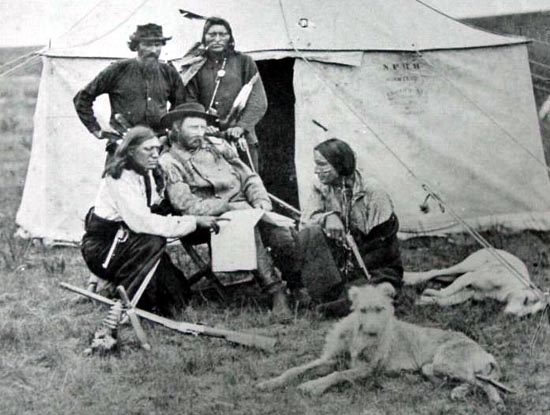 Custer and his dogs with Crow Scouts
Custer and his dogs with Crow ScoutsThere were, of course, horses at Little Big Horn, but there were also other animals – pets among them.
Custer wrote home to his wife “Tuck regularly comes when I am writing, and lays her head on the desk, rooting up my hand with her long nose until I consent to stop and notice her. She and Swift, Lady and Kaiser sleep in my tent.” His dogs were trained to run alongside his horse that could be how Tuck died in the battle. The other dogs had been left at camp with their caretaker.
The horses have far stranger stories. Aside from the trench of horses mentioned above, there were mysterious horses like Little Soldier, the horse of Bobtailed Bull, an Arikara scout working with Major Marcus Reno. After Bobtailed Bull had died in battle, Little Soldier made his way over 300 miles back to his home in the Dakota Territory.
Another horse was found by General Godfrey on the Yellowstone River. It was missing nothing. It had its halter, saddle, and bit – everything down to the oats to feed it. The saddle bags were empty, but the general was told that they did hold a carbine when first discovered. The horse had been shot in the forehead. There was no sign of the rider.
A horse that showed up in Canada after its sale by the Sioux was recovered by the Mounties, and after U.S. approval, the RMP superintendent, James Morrow Walsh was allowed to keep it. He named him “Custer”.
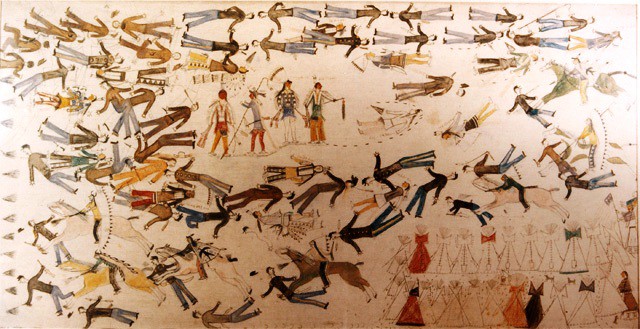 Battle of Greasy Grass
Battle of Greasy GrassThere are several paintings of the battle done by Indians, the most famous of which was done by Kicking Bear, a Sioux warrior and a later performer in Buffalo Bill Cody’s Wild West show. From his perspective, the central focus is himself, Crazy Horse, Rain In The Face, and Sitting Bull. It also features Custer and the departing spirits of the deceased. Red Horse pictographic account of the Battle of the Little Bighorn, 1881
Red Horse pictographic account of the Battle of the Little Bighorn, 1881
Red Cloud also shared his perspective in a pictograph.
Captain Grant Marsh of the Far West Steamboat was the first to deliver the news of what happened at Custer’s Last Stand. His mission had been to take supplies to Custer, but instead, he ferried 51 wounded soldiers away from the massacre.
To do this, he had to drop some weight. Rather than drop the fuel needed for steam, or supplies needed for the men, he chose to drop $375,000 worth of gold bars on the shores of the Bighorn River. It has never been recovered.
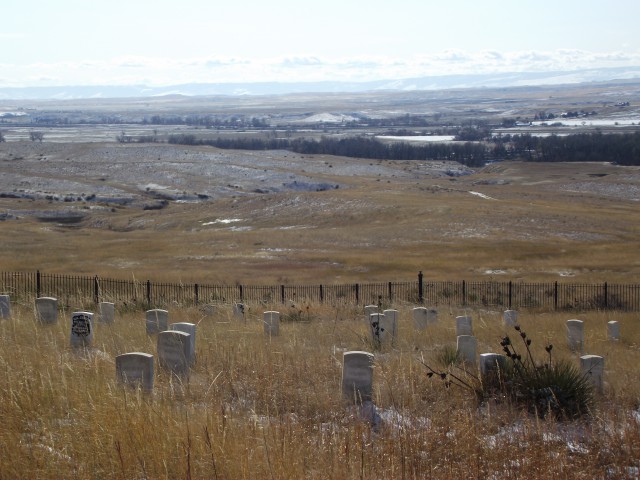 Little Bighorn Battlefield National Monument Montana. By 1025wil CC BY-SA 3.0
Little Bighorn Battlefield National Monument Montana. By 1025wil CC BY-SA 3.0If you visit the battlefield at Little Big Horn, there is a visual cue for gaining perspective on how the battle went down.
Each marble marker marks the spot where a soldier fell. Originally, they were buried where they died, but the bodies were moved later. The markers remain.
The places where the soldiers fell are marked with white marble headstones, so from afar you can get a picture of what the aftermath looked like.
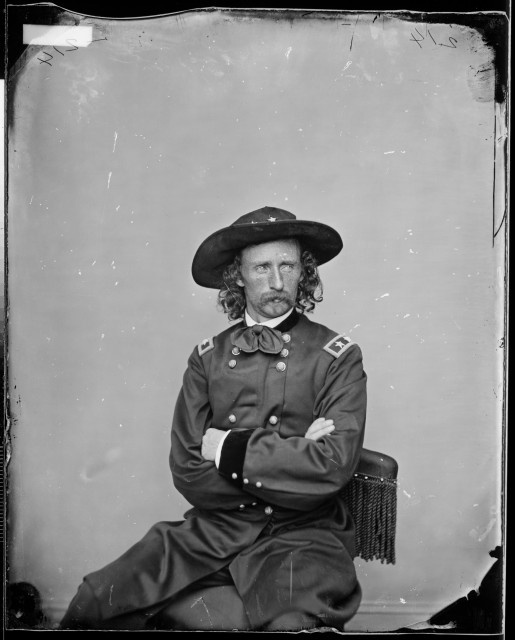 Gen. George A. Custer
Gen. George A. CusterCuster’s life is a mishmash of failure, brazen luck, and some success, but he wasn’t the hero or anti-hero portrayed in movies.
He was known as a prankster at West Point and graduated as the lowest ranking cadet.
Most people believe he was a general, and he was for a while during the Civil War – a Brevet Major General. After the war, the rank reverted to Captain and remained so for the rest of his career.
He was court martialed twice – once for going AWOL to visit his wife.
During a campaign in Texas, the soldiers continually gave him gruff and balked at his discipline, and thought of him as a “vain dandy.” Custer was known for his appreciation of his hair and his attention to it with cinnamon oil for scent and other treatments.
Most of the legend surrounding Custer was embellished or even made up by Custer’s wife during speeches throughout her life, and by the shows put on by a friend and fellow soldier, Buffalo Bill.
It’s amazing what modern archeology and good investigation can accomplish.
Studies underway at Little Big Horn Battlefield National Monument are so advanced that researchers can find a bullet on the ground and track where it was shot from, who shot it, and how adept at fighting the soldier was.
They conduct their research with metal detectors and microscopes and match firing pins to rifle cartridges. They are also working with new translations of Native American accounts of the battle.
That, and the bureau of ordinance doggedly refused to upgrade the weaponry to repeaters, they wanted to stick with the single shot rifles as they felt that soldiers would panic and waste ammunition otherwise.
This is a massive over simplification, it was a bit more involved than that.
Custer was brevetted to Major General of Volunteers in 1864. In 1866, he reverted to his permanent Regular Army rank, Captain. Shortly thereafter, the Regular Army reorganized, and Custer was appointed as the Lieutenant Colonel of the newly raised 7th Cavalry. Since the Colonel of the 7th Cavalry never joined his command, serving on other duties, Custer commanded the Regiment. Most West Point graduates and Regular Army officers had similar stories, they served with the Volunteers in much higher grades and had to go back to their Regular Army rank when the war was over.
Brevet rank was usually awarded for performance in combat, recipients were entitled to the title, by courtesy, and could wear their Brevet uniform. This reads like most pirate stories, short on facts.
Had Custer won at the Little Big Horn, the battle today would simply be relegated to a footnote in the Indian wars and soon forgotten like many bigger battles.
This would mean that THE WASHITA battle would also have been nothing but a little “dust-up” on the High Plains, and without Black Kettle being killed there, Sand Creek would also have been forgotten. Black Kettle’s band was instigated to fight by Confederate Agents in the tribe.
Just for the record, during 1868, at the Washita, the Cheyenne and Arapaho were NOT on their reservation, but almost 90 miles SW of there. their reservation at that time was East and north of the Cimarrron River, West of the Arkansas river and South of the Kansas line. The old former Cherokee strip.
Instead, they were camped on the Washita, in the former Choktaw-Chikasaw lands.
They were not given the Washita area till several years later.
Indeed so. Who wrote this tripe?
In Bourke’s book ON THE BORDER WITH CROOK he mentions how before the battles, traders were selling tube magazine rifles to the tribesmen.
He says once the warriors were armed with such weapons they became “surly”. It would be considered the a-s-s-ault rifle of the day, yet no one called for banning them.
When Crook attacked several of the Cheyenne villages, and burned them, the camps actually exploded, there was so much ammo and gunpowder there.
I’d take their “facts” with a grain of salt. “After the war, the rank reverted to Captain and remained so for the rest of his career.” He was promoted to Lt Colonel when he assumed command of the 7th. https://www.nps.gov/libi/learn/historyculture/lt-col-george-armstrong-custer.htm
#3 That was Custer’s Last Pie.
#41 Like the British officers who would not hand out the ammo they had at the first Zulu battle.
I always liked Custer after reading an account of a Civil War battle where he rode up to the command tent where the Generals were sitting around studying maps. The Union had won the upper hand in the battle and the Confederates were in full retreat. The Generals were hesitant and overcautious to follow up on the victory as Custer burst in screaming at them to keep fighting. They said something like they couldn’t find a place where the army could cross the river. Custer ran out jumped on his horse rode to the middle of the river outside the tent screaming and cursing at them saying right here is where we can cross. It was too late when they finally did realize he was right. I wish I was better on specifics but that scene always stuck with me.
That was the fate of Jacob Greathouse and his wife, as recounted in "The Frontiersmen", and excellent book by historical fiction writer Allan W. Eckert.
There are many nouns that both singular and plural are the same word. Moose, deer, aircraft are the first ones that pop into my head.
I take your general point but the Little Bighorn would have been more than a footnote even had Custer won. Custer encountered the largest assemblage of hostiles in the history of plains warfare, and probably Indian warfare generally north of Mexico. The battle was a black swan event. Plains Indians did not travel in groups of 7- 10,000 people. They lived by hunting and had to disperse to find adequate game. A couple of hundred people would have been a very large village. Most were smaller. In this case, the Indians had concentrated to fight Crook on the Rosebud and had not yet scattered. Custer showed up at an unlucky time. His decisions make a lot more sense if one remembers that he was encountering something outside any normal frame of reference. A cavalry regiment should have been more than a match for anything it was likely to engage.

Since lions, tigers and elephants sometimes are born in zoos in America, does that mean lions, tigers and elephants are native to America?
“By any objective standard George Armstrong Custer was one of the worst men ever to be commissioned an officer in the US Army...” [jmacusa, post 6]
“... Most West Point graduates and Regular Army officers had similar stories...served with the Volunteers ...back to their Regular Army rank when the war was over.
Brevet rank was usually awarded for performance in combat, recipients were entitled to the title, by courtesy, and could wear their Brevet uniform. This reads like most pirate stories, short on facts.” [centurion316, post 42]
“I’d take their “facts” with a grain of salt. “After the war, the rank reverted to Captain and remained so for the rest of his career.” He was promoted to Lt Colonel when he assumed command of the 7th...” [pacific_waters, post 6]
“One interesting thing I heard ...was that Custer had two horse-drawn Gatling Guns available to him, but left them at the fort because he thought they’d slow him down...” [chaosagent, post 30]
jmacusa is assuredly entitled to an opinion, but might read up on West Point history, the American Civil War, and US military personnel practices before venturing additional ones.
_The Class of 1846_ by John C Waugh (Ballantine, 1999. ISBN-10: 034543403X; ISBN-13: 978-0345434036)
_Sacred Ties_ by Tom Carhart (Dutton, 2011. ISBN-10: 0425239101; ISBN-13: 978-0425239100)
_Exploring With Custer_ by Ernest Grafe & Paul Horsted. (Golden Vally Press, 2002 {Third Edition}. ISBN-10: 0971805318; ISBN-13: 978-0971805316)
_The Class of 1846_ informs us about USMA’s class of 1846 and how its members fared, as cadets and later as officers. Plenty of detail on early West Point. Prior to the 1840s, USMA was an engineering school. Performance of grads in the Mexican-American War set the public on the path that would help them judge differently.
_Sacred Ties_ follows the lives of six West Pointers (George Armstrong Custer, Stephen Dodson Ramseur, Henry Algernon du Pont, John Pelham, Thomas Rosser, and Wesley Merritt) who were still cadets as the American Civil War began: they had forged a special personal bond since entering. In asserting that Custer was “Reckless, frequently insubordinate, he cared little if anything for the welfare of his men...” jmacusa is not only factually inaccurate but intellectually dishonest and largely uninformed.
Before ACW, West Point had not yet become the school of secret hazing rituals, petty humiliation as embodied in the class system, or scores of dutiful cadets being dictated to and punished by martinet tac officers. The Honor Code did not yet exist. America of the early 19th century had no urban sheep; a certain frontier rambunctiousness and a small-r republican egalitarianism still existed. Cadets did not kowtow to officers as they did later, still less would they defer to civilian instructors (of which there were some then). By these less-stringent standards, Custer wasn’t a standout; “reckless” is arguable but more subjective. Such is sometimes needed in action; timidity and deference can get you killed.
One epithet jmacusa somehow failed to include was the accusation that Custer graduated without completing the prescribed academic program. It is true in a sense: when Custer & classmates entered, the program was four years in length, but political developments in Europe (widespread revolts in 1848) caused authorities to increase the program to five years, incorporating more instruction in foreign languages, geography, politics, and international affairs. On the outbreak of civil war in April 1861, demand for qualified officers led to the immediate graduation and commissioning of the First Class, followed by graduation and commissioning of the Second Class in early July, skipping the extra academics. Custer graduated with that second Class of 1861.
US military personnel policies have long been complicated and bedeviled by indifference during peace, followed by panicked buildups at the outset of war, to be followed by ruinous steep, sudden reductions after war. The civilian administrators were never shy about appointing officers to whatever rank they thought was need: hence the direct entry of many as colonels or higher.
The use of temporary rank was continued until personnel policies were subject to somewhat rational reform in the 1980s. George Custer and a couple others were hurriedly promoted to high rank during severe shortages early in ACW - a frankly political move was taken in desperation, but the blind stab turned out decently in Custer’s case. The others worked out OK too.
By the late 1860s the armed forces had been severely reduced in size and many reduced to permanent rank. This did embitter many who had been junior or mid-rank officers during the war, as they were reduced to enlisted status if they chose to remain in uniform. Custer had been popular during the war with his volunteers (many of whom had also hailed from Michigan), but he did become indifferent to the motley group of underlings he commanded from 1865 until his demise in 1876. The distinction between officer and enlisted was much wider back then; one gets the impression from diaries and journals of those he commanded that the officers enjoyed themselves, while the enlisted soldiers suffered and groused (cautiously and quietly).
In summer 1876, the 7th Cavalry did not leave the Gatling Guns at Fort Abraham Lincoln. As big and as weighty as field pieces, they trundled right along on their wheeled carriages with the rest of the supply wagons and the baggage train. On the morning of 25 June 1876, the 7th got word of the Indian camps along the Little Big Horn; Custer ordered the regiment to head directly at the Indians - across very rough territory. The Gatlings, and the rest of the wheeled vehicles assigned, were left behind because they could never have made it across what is essentially a small stretch of badlands terrain. Custer did not leave his supporting arms behind for whimsical reasons.
_Exploring With Custer_ is sort of a travel book. detailing the US military expedition to and through the Black Hills, July-August 1874, which Custer commanded. This expedition was one of the first to be accompanied by a photographer, who took dozens of pictures and later published many, which sold well and increased popular interest in a then-remote region. By the final years of the 20th century, fading local legend, changes in vegetation, and alterations of the terrain through mining had caused confusion about where the original picture-snapping locations had been, so Ernie Grafe and Paul Horsted resolved to document as many as they could, before knowledge vanished completely. They snapped photos of their own, included detailed maps and GPS data, and added day-by-day commentary in the words of the original expedition members excerpted from the diaries & journals many had kept. The book contains a long series of before-and-after images and is a great travel book for the historically inclined, plus a fascinating read for those curious about the real “Old West.”
Have you read "That Dark and Bloody River" by the same author? It's about the settlement of the Ohio River valley.
Wow, that blogger has a hard-on for Jews.
Maybe it is me but I was always sold on this image that the natives were completely helpless. Far from it. These guys were accomplished warriors that embarrassed Grant.
According to what I just watched “The American West” he foolishly would not wait for the other two armies, and wanted the glory for himself.
Disclaimer: Opinions posted on Free Republic are those of the individual posters and do not necessarily represent the opinion of Free Republic or its management. All materials posted herein are protected by copyright law and the exemption for fair use of copyrighted works.